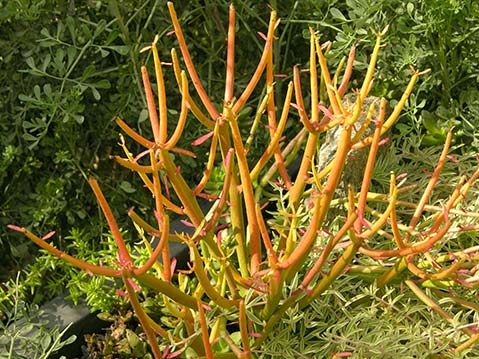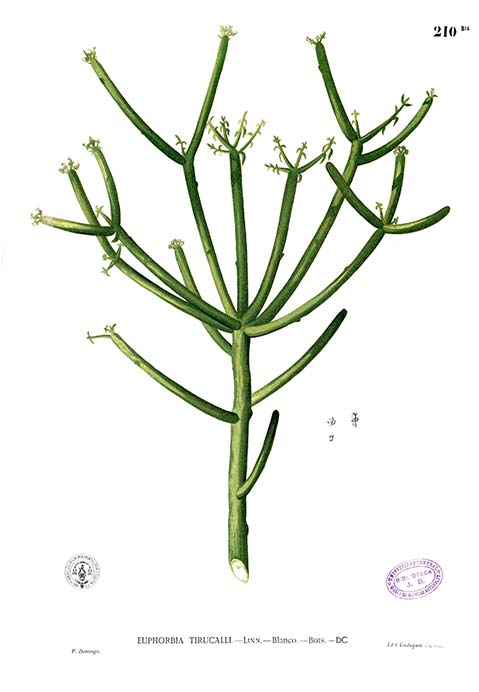Gardening: Sticks on Fire, Not So Dire
Toxic Plants Can Add Beauty to Your Garden If Handled Correctly

A Santa Barbara Independent reader wrote in to suggest a possible story based on an incident she had while working in her garden. It seems that her husband was in the yard, trimming the branches on their ‘sticks on fire’ plant (Euphorbia tirucalli). Apparently, she became very ill and was in substantial pain for a week after cutting up the branches and disposing of them in the green bin. Since her close call with this plant, the reader has noticed how prevalent this showy, succulent, yet potentially dangerous plant is in the landscapes and gardens around town.
Well, this scenario does not surprise me since one of the characteristics of the plants in the Euphorbia genus is that many of them have an often poisonous, white, latex-like sap. Depending on the type of Euphorbia — whether it be a poinsettia, crown of thorns, African milk tree, or the previously mentioned sticks on fire, the plants can vary in toxicity. How toxic the plant is also depends on whether you eat it, get the sap on your skin, or, worse yet, get the sticky white stuff in your eyes.
In part of the description for this plant on the San Marcos Growers website (website), President and General Manager Randy Baldwin writes, “Be very careful when handling this plant as the stems break easily and the milky sap can burn the skin or cause welts if one is sensitive to it, and certainly is not something to get into the eyes. When working with this plant, use protective goggles, and if you do get it in the eyes seek medical attention promptly. For this reason, this plant should also not be planted near paths or locations where a casual visitor to the garden might accidentally come in contact with it.”

Baldwin unofficially mentioned that there is a folk remedy to use as an antidote in the event that a person gets the sap of sticks on fire in their eyes. He suggested I call retired UCSB horticulturist John Bleck to find out more about this.
Mr. Bleck, who is absolutely the last word on everything plants and an old swimming buddy of mine, suggested that if you’re using sticks on fire in your landscape, you may also want to consider growing Aeonium sedifolium and Aeonium lindleyi since the sap from both of these succulents acts as an antidote to the worrisome Euphorbia. He also added that although this striking and colorful plant makes a nice contrast in the garden — almost as if something were in bloom — it is best not planted in high-traffic areas where people and pets may come in contact with it.
Okay, this is my take on all of this. I would hope that folks don’t get unduly alarmed and run willy-nilly out to their gardens and start yanking their sticks on fire plants out of the ground. If they do this, they may as well dig out their azaleas, rhododendrons, hydrangeas, angel’s trumpet (Brugmansia), oleanders, foxglove, and larkspur, too. And while they’re at it, they can go in the house and dispose of their devil’s ivy (Pothos), mother-in-law’s tongue (Sansevieria), peace lily (Spathiphyllum), and dumb cane (Dieffenbachia). Oh, and don’t forgot to confiscate your grandmother’s anemic and dusty philodendron because, yes, amigos, all of these plants are also toxic to some degree.
My point is this: You wouldn’t landscape your daycare center playground with saguaro or prickly pear cactus, right? Well, sticks on fire is a plant that can add beauty and interest to your garden. If you are drawn to this plant and want to use it in your landscape as well as other potentially toxic or threatening plants, google them, educate yourself, be aware of the risks, and use them appropriately and with caution.



